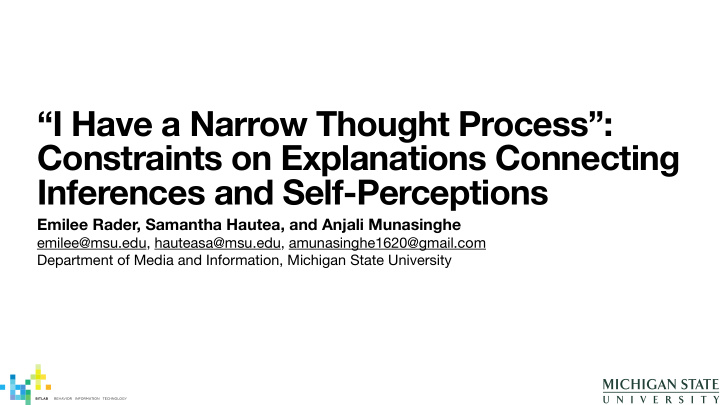



“I Have a Narrow Thought Process”: Constraints on Explanations Connecting Inferences and Self-Perceptions Emilee Rader, Samantha Hautea, and Anjali Munasinghe emilee@msu.edu, hauteasa@msu.edu, amunasinghe1620@gmail.com Department of Media and Information, Michigan State University
https://www.flickr.com/photos/newspaperclub/20905735770/
https://cdn.arstechnica.net/wp-content/uploads/2017/04/internet-noise.jpg
Facebook Ad Preferences Google Ad Settings
Our Approach... • Show people the inferences Facebook or Google had made about them • Elicit participants' explanations for the connection (or lack thereof) between themselves and the inferences • Focus on why some inferences may be easier for them to relate to themselves than others • Understand what makes inferences make sense to people • Identify implications for informed consent to inferences
Step 1: Survey to rate inferences 95 respondents, 44 Facebook and 51 Google • sensible : It makes sense that [inference] is associated with me. • relevant : [inference] is relevant to who I am as a person. • accurate : [inference] is an accurate description of my everyday activities.
���������������������������������������� ������������������������������������������������������������������������������������������������� ���������������������������������������������� ��������������������������������������� �������������������������������������������������������� Step 2: Interviews about reactions ��������������������������������������������� ������������������������������������������������������������������������������������������������������ ������������������������������������������������������������������ �������������������� Number of Mean ID Gender Age Aware? Inferences Accuracy P01 Woman 62 No 20 5.05 Facebook Participants P02 Woman 28 No 26 5.44 P10 Man 44 Unsure 25 4.48 P11 Man 63 No 24 5.62 P13 Woman 28 No 33 4.39 P15 Woman 44 Yes 14 4.00 P16 Woman 34 No 25 4.84 P20 Man 38 Unsure 26 4.42 P03 Man 38 No 59 4.05 P04 Woman 32 No 98 4.76 P05 Man 29 Yes 63 2.32 P07 Man 71 No 62 4.44 Google Participants P08 Woman 59 Unsure 83 4.49 P09 Woman 63 No 40 4.78 ���������������� P12 Man 31 No 48 3.77 P14 Man 30 No 94 4.68 P17 Woman 48 No 65 3.54 P18 Woman 30 No 104 3.87 ����������������������� P19 Man 38 No 44 3.05 P21 Woman 40 No 46 4.00 P22 Woman 43 No 109 3.07
Types of reactions Plausible, Implausible, and No Connection Plausible reactions: Implausible reactions: No Connection reactions: were believable, with specific were initially not believable, did not make sense, and evidence for why it made but then rationalized participants were certain it did sense not apply to them Example: Example: Example: [Parents (All)] Because I have [Co ff ee & Tea] I don’t drink [Golf Equipment] I don’t know three kids, well, a lot of my co ff ee. My husband does why that’s on there... golf though. So again maybe, equipment? I don’t golf. posts are about my kids . – you know? –P18, Woman, That’s weird. –P04, Woman, P13, Woman, Facebook Google Google
Acceptance and Discomfort Coexist “I mean, there’s a level of acceptance that it happens, but then the more you think about it, it kind of starts to disturb you a little bit more ... some of the things that they make connections for, it takes you a while in your head to get to how they got to that. And it’s a little bit, I don’t know, disconcerting or something. It’s just a little bit uncomfortable.” –P22, Woman, Google
Platforms which place a priority on obtaining truly informed consent should restrict the inferences they make about users to those which provoke plausible reactions.
Thank You! “I Have a Narrow Thought Process”: Constraints on Explanations Connecting Inferences and Self-Perceptions Emilee Rader, Samantha Hautea, and Anjali Munasinghe emilee@msu.edu, hauteasa@msu.edu, amunasinghe1620@gmail.com Department of Media and Information, Michigan State University This presentation is based upon work supported by the National Science Foundation under Grant No. CNS-1524296.
Recommend
More recommend